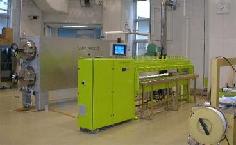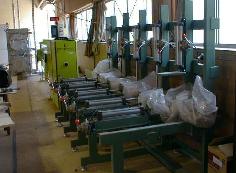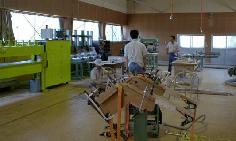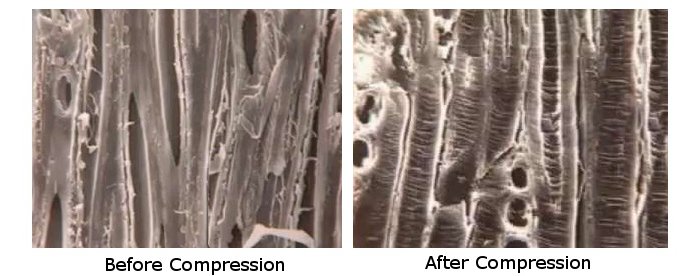- Home
- Discover Extreme Wood Bending
- How it's made
Our Store Pages
How it's made
|
Cold-Bend™ hardwood undergoes extreme physical, longitudinal thermo-mechanical compression. There is no chemical treatment, or glues used in the process. Cold-Bend™ hardwood is solid hardwood that has been selected and milled to yield clear lumber. It is carefully controlled for moisture content. Cold-Bend™ hardwood is not modified in any way except for the extreme compression and the careful quality selection and moisture control required for its extreme bending qualities. Wood used for compression must be clear and straight grained - essentially veneer quality temperate hardwoods (i.e. ash, oaks, cherry, maple, walnut) . Softwoods and import lumber does not work in this process. After sawing from the log, the green, wet boards are partially dried over a period of a few months to years, then sawn and planed to the required dimensions. The patented and trademarked Cold-Bend™ hardwood process begins by steaming the planks under pressure in a long autoclave. The plasticized boards are then placed in the compression chamber of the Cold-Bend™ hardwood press, which compresses it lengthwise to about 75 to 85 percent of its original length, while maintaining the other dimensions. The wood is altered at the cellular level. You can think of the normally rigid cell walls as sliding into or folding over on themselves. Imagine a drinking straw, and a hospital straw, and you will get an idea of the difference between hardwood and compressed hardwood. You may also think of the compression as producing a bellows effect in the cell walls. The electron micrographs below show wood cell walls with and without compression. Once removed from the press, the wood returns to about 10 percent of its original, trimmed length during a process called "Compression Resting". It is immediately set into a second press where the forces are allowed to equalize throughout the compressed planks. After compression and resting, the wood retains amazing flexibility, as long as it is kept moist, making it suitable for bending cold, by hand. The compression allows the wood to both stretch on the outside of the curve (something wood can't otherwise do) and further compress on the inside of the curve without backing straps, heat or steam. The wood is flexible until dried, so it can be bent onto or over a fixture while wet, then dried to fix the shape. The dried wood is rigid, and is identical to the original wood, except that by now it has probably taken on some cool new shape. About 5 to 10% of the original strength of the wood may be lost, insignificant in most applications, and usually better than other shaping methods like steam, lamination and sawing curves. Maximum net production size is 3.5 x 6" x 100", but is more typically produced in planks that are 1" to 2" thick x 6" wide x 8' long. Cold-Bend™ hardwood is only manufactured in one location in the Americas - in Gig Harbor, Washington, by Pure Timber LLC. Cold bendable compressed wood is available in a range of species and sizes. There are a few presses in Europe and Asia in furniture plants (picture Windsor chair backs), or supplying furniture manufacturers. Pure Timber LLC is the only wholesale or retail supplier of Cold-Bend™ hardwood worldwide to consumers, woodworkers, and production factories.
|
 Loading... Please wait...
Loading... Please wait...







